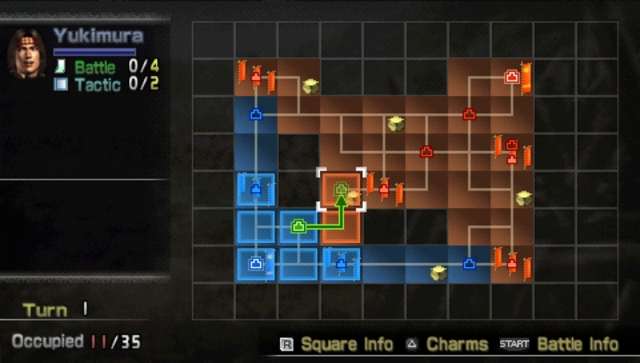Samurai Warriors: State of War
A very civil war.
"State of War?" Like there's ever been any other kind of state in a Samurai Warriors game? Samurai Warriors: Permanent Ceasefire - now that would be something to sit up and take notice of. But that's never going to happen, and frankly we wouldn't want it to. The idea of six million unemployed soldiers sitting around polishing their choppers doesn't really appeal. And so the war goes on, now spilling over onto PSP screens.
Followers of the series will know what to expect: frantic battles set on the barren plains of old civil war Japan. The game is split into two sections: the Strategy Phase and the Action Phase. The Strategy Phase presents each scenario as a tactical map, with each square colour-coded according to whether it's under the control of allied or enemy forces. Movement around the map is restricted to preset paths, and these are often blocked by water or enemy defences. Entering an enemy square moves you on to the Action Phase.
Not surprisingly, this is where it all happens. The job demanded of you and your men varies depending on the type of square you've entered. A generic slab of featureless occupied territory may simply require a certain number of enemies to be slain within 60 seconds in order to take control and advance, while the invasion of an enemy stronghold could see you taking out all the generals to tip the balance of power in your favour.
Either way, the action is pretty much the same, with gangs of enemy soldiers tracked down with the help of the radar before being battered to death with a wide range of ancient Japanese weapons. You're not alone on the battlefield, and entering the fray with Subofficers gives you additional strengths and powers depending on their own specialities. For example, team up with a Subofficer that lists "Steed" among their powers and you'll find yourself trampling the bad guys from horseback.

Basic hacking of the mostly brain-dead enemies charges up a Musou gauge, which when full allows you launch into frenzied combo attacks. You're also granted a last chance as your health bar bottoms out, with an instant Musou boost offering a way out of a sticky situation. One day Koei will address the age-old camera problem that comes as standard with all Samurai Warriors games, but until then, we'll have to make do with constantly running away from groups of enemies, turning to face them, flicking the L button to spin the camera round and then running back to chop them up.
Each plotline takes your chosen character through a number of missions, each made up of bite-sized battles alternating with moves around the map in the Strategy Phase. Once you reach the end of a particular story, you can either take your levelled-up character off into a new story, or build up a new character from scratch.
Unlike last year's PSP Dynasty Warriors, which limited the action to a 4:3 rectangle in the centre of the handheld's screen with stats on either side, this time the action is in full widescreen. There's also wireless competitive multiplayer for up to four players.

Sacrifices have been made in order to keep the mayhem as busy and frantic as possible, and it's the draw distance and environments that have taken the brunt of the cutbacks. Warriors are numerous and well detailed, but there really is literally nothing to see in the battle zones. The sound mirrors the action, with the same wooshes, bangs and clanks tinkling out of the PSP's little speakers as if on a five-second loop.
Simplistic as the basis of the game is, there are plenty of little carrots dangled in front anyone with the will to develop their characters, with stacks of magical charms, skills, abilities and weapons to be earned, and combos and more advanced moves to be learned.
While the gameplay is incredibly repetitive, the Strategy Phase introduces some depth and direction to the battles, breaking things into manageable chunks suited to gaming on the move. There's also very little disc access, so it'll keep going for ages on a single charge. It's also strangely addictive in an almost subconscious way. If you've ever bought a big bag of monkey nuts, shelled and munched a couple, started surfing the net and then come to your senses an hour later to find you've unwittingly scoffed the lot... well, it's a bit like that.
